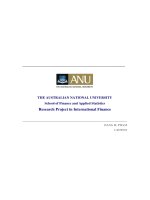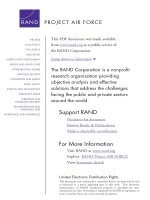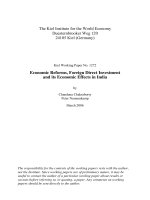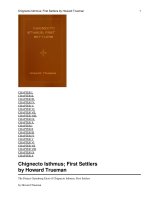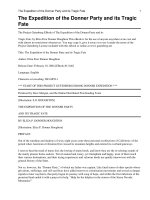Corrosion and its types
Bạn đang xem bản rút gọn của tài liệu. Xem và tải ngay bản đầy đủ của tài liệu tại đây (330.27 KB, 30 trang )
Corrosion and its types
What is Corrosion
Corrosion may be defined as the gradual destruction of metals by the chemical or
electrochemical reaction with the environment. During corrosion, the metals are
converted to their metallic compounds at the surface. The loss of materials due to
corrosion has become a great problem. The most common example for corrosion is the
rusting of iron when it is exposed to atmospheric conditions. The rusting is due to the
formation of hydrated ferric oxide on the surface. Another example is the formation of
green film of basic copper carbonate on the surface of Cu, when exposed to moist air
containing CO .
2
Corrosion: Metallurgy in Reverse2
Corrosion Metallurgy in Reverse
2
Fontana, M.G., Corrosion Engineering. 3rd ed. 1986, New York: McGraw-Hill.
4
Study of corrosion is important because
Materials are Precious resources
Engineering design is incomplete without knowledge of corrosion
Applying knowledge of corrosion protection can minimize disasters
Corrosion- may contaminate stored food, dairy products , etc
Corrosion products cause pollution
Artificial implants for the human body ?
Theories of corrosion
1.
2.
Direct Chemical Corrosion or Dry Corrosion
Electrochemical Corrosion Or Wet Corrosion
Direct chemical corrosion or dry theory of corrosion
This type of corrosion occurs mainly through the direct chemical
action of atmospheric gases such as O , halogens, H S, CO ,
2
2
2
SO , N , H or liquid metals on metal surface in the absence of
2 2 2
moisture.
There are 3 types of chemical corrosion
Oxidative corrosion
It
is brought about by the direct action of O
2
present in the
atmosphere on metals at low or medium temperature in the
absence of moisture to form metallic oxides. Alkali and alkaline
earth metals are rapidly oxidisesd even at low temperature. At
high temperature almost all metals except (Ag, Au, Pt, Pd) are
attacked.
Liquid metal corrosion
It
is due to the action of following liquid metal at high
temperature on solid metal or alloy. This type of corrosion is
found in nuclear power plants. Corrosion takes place either due
to the dissolution of solid metal by the liquid metal or due to the
penetration of liquid metal in to the solid metal.
Corrosion by other gases
CO2, SO2, Cl2,H2S, F2 also have corrosive actions on metals.
The extent of corrosion depends on the affinity of the metal and the gas involved in corrosion.
If the film formed is protective then extent of corrosion decreases, Cl 2
If the film is non protective it destroys the metal. Chlorine gas attacks Sn to SnCl 4 which is volatile and leaves the
metal exposed for further attack.
H2S gas attacks steel forming FeS layer which is porous in nature.
ELECTROCHEMICAL CORROSION
OR
WET CORROSION
This type of corrosion occurs when :
1.
2.
A metal is in contact with a conducting liquid
Two dissimilar metals or alloys are immersed partially in a conducting
solution.
This corrosion is due to the existence of separate anodic and cathodic
areas between which current flows through the conducting solution.
Mechanism
Electrochemical
corrosion involves the flow of electron current between
the anodic and cathodic areas. One part of the metal becomes anode and
the flow of electron current between the anodic and cathodic areas takes
place through an electrolyte in contact with it. The anodic reaction
involves the dissolution of metal to metallic ions with the liberation of
electrons. Hence corrosion always takes place at the anodic area.
At anodic area, M Mn+ + ne- (oxidation)
The cathodic reaction consumes ne- with
either by the
evolution of H or absorption of O depending on the nature of
2
2
environment.
Evolution of hydrogen
In acidic medium, the cathodic reaction takes place by the evolution of H2
. Consider the corrosion of iron. The anodic reaction is the dissolution of
2+
Fe as Fe
ions with the liberation of electrons.
2+
Fe
Fe
+ 2e- (Oxidation)
Now these electrons flow through the metal from anode to cathode where
these electrons are taken by H+ ions present in acidic solution forming
+
2H
+ 2eH (Reduction)
2
Absorption of oxygen
In neutral or slightly alkaline medium, the cathode reaction takes
place with the absorption of atmospheric O . In this type, the
2
electrons liberated from Fe flow from anodic to cathodic areas
where these ne- are received by O dissolved forming OH ions
2
½ O + H O + 2e2OH (reduction)
2
2
The liberated Fe2+ ions at the anode and OH- ions at the cathode diffuse
and combine to form the first corrosion product namely Fe(OH) .
2
Fe2+
+ 2OH
-
Fe(OH)
2
In presence of excess of O2, Fe(OH)2 is changed in to Fe(OH)3 with the
composition Fe
3+
2Fe(OH)2 + ½ O2
O . 2H O which is known as rust.
2 3
2
Fe O . 2H O rust
2 3
2
TYPES OF ELECTROCHEMICAL CORROSION
Galvanic corrosion
Concentration cell corrosion
a) Drop corrosion
b) Water line
Pitting corrosion
Crevice corrosion
Erosion corrosion
Soil corrosion
Stress corrosion
Intergranular Corrosion
Microbiological corrosion
Selective leaching corrosion
Hydrogen damage
Stray current corrosion
Galvanic corrosion
Concentration cell corrosion
This
type of corrosion is due to electrochemical attack on the metal
surface exposed to an electrolyte of varying concentrations. Metal in
contact with lower concentration will act as anode and undergoes
corrosion. It is observed in chemical plants and storage tanks and also in
marine structures like ships. Differential aeration corrosion is the most
important.
Differential aeration corrosion
This type of corrosion occurs when one part of the metal is exposed to a different air
concentration from the other part. This causes a difference in potential between
differently aerated areas. It is found that less oxygenated part acts as anode more
oxygenated part acts as cathode.
Corrosion of metals partially immersed in a solution is due to differential aeration
corrosion. Consider a Mg rod partially immersed in NaCl solution. The areas of Mg rod
above and just below the water line are more oxygenated and will act as cathode. The
remaining part of the rod which is well under the solution is less oxygenated and act
as anode and undergone corrosion.
Pitting Corrosion
Pitting
corrosion is a localized accelerated attack resulting in the
formation of pin holes, pits and cavities on the metal surface. It is due to
the breakdown or cracking of the protective film on the metal at specified
points. This gives rise to the formation of small anodic and large cathodic
areas. Once a small pit is formed the rate of corrosion will be increased
Crevice corrosion
It is produced at the region of contact of metals with metals and non metals.
It occurs at the crevice between different metallic objects such as bolts, rivets, nuts
etc.
When these crevices come in contact with the liquids these become the anodic
region because oxygen supply to these areas is restricted compared to exposed
areas which become the cathode.
Intergranular corrosion
When a molten metal is solidified starts at number of randomly distributed nuclei within the molten
mass then each of them grow in a regular pattern or atomic to form grains.
Grain boundaries are generally more prone to corrosive attack. Grain centres behave as the
cathode and grain boundaries as anode.
Aluminium copper alloys are attacked by this type of corrosion.
